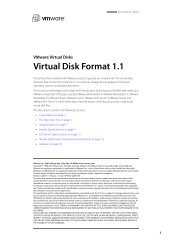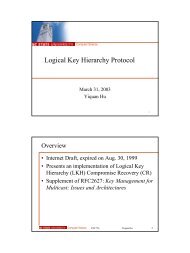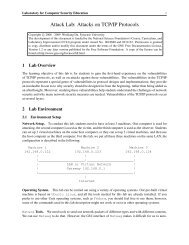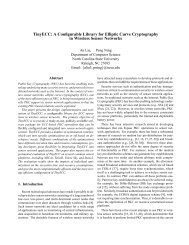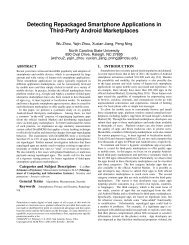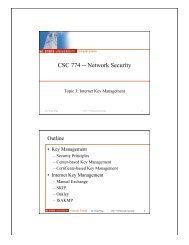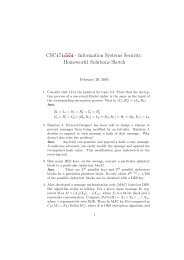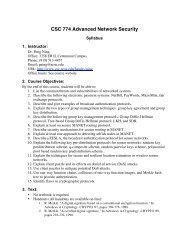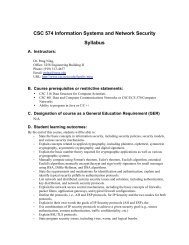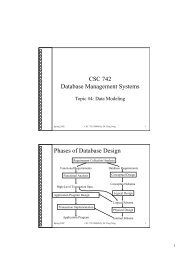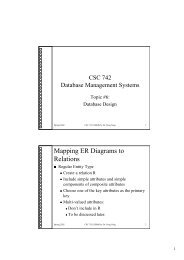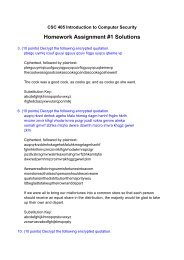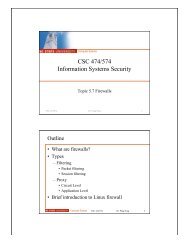Correlating Alerts Using Prerequisites of Intrusions - Dr. Peng Ning ...
Correlating Alerts Using Prerequisites of Intrusions - Dr. Peng Ning ...
Correlating Alerts Using Prerequisites of Intrusions - Dr. Peng Ning ...
You also want an ePaper? Increase the reach of your titles
YUMPU automatically turns print PDFs into web optimized ePapers that Google loves.
Acknowledgement The first author would like to thank Robert Cunningham and David Fried for providing<br />
the NetPoke program.<br />
References<br />
[1] J. P. Anderson. Computer security threat monitoring and surveillance. Technical report, James P.<br />
Anderson Co., Fort Washington, PA, 1980.<br />
[2] R.G. Bace. Intrusion Detection. Macmillan Technology Publishing, 2000.<br />
[3] CVE Editorial Board. The common vulnerabilities & exposures. http://www.cve.mitre.org.<br />
[4] D. Curry and H. Debar. Intrusion detection message exchange format data model and extensible<br />
markup language (xml) document type definition. Internet <strong>Dr</strong>aft, draft-ietf-idwg-idmef-xml-03.txt,<br />
February 2001.<br />
[5] O. Dain and R.K. Cunningham. Fusing a heterogeneous alert stream into scenarios. In Proceedings <strong>of</strong><br />
the 2001 ACM Workshop on Data Mining for Security Applications, pages 1–13, November 2001.<br />
[6] H. Debar and A. Wespi. Aggregation and correlation <strong>of</strong> intrusion-detection alerts. In Recent Advances<br />
in Intrusion Detection, number 2212 in Lecture Notes in Computer Science, pages 85 – 103, 2001.<br />
[7] D.J. DeWitt, R.H. Katz, F. Olken, L.D. Shapiro, M.R. Stonebraker, and D. Wood. Implementation<br />
techniques for main memory database systems. SIGMOD Record, 14(2):1–8, 1984.<br />
[8] K. Ilgun, R. A. Kemmerer, and P. A. Porras. State transition analysis: A rule-based intrusion detection<br />
approach. IEEE Transaction on S<strong>of</strong>tware Engineering, 21(3):181–199, 1995.<br />
[9] Inc. ISS. RealSecure intrusion detection system. http://www.iss.net.<br />
[10] H.S. Javits and A. Valdes. The NIDES statistical component: Description and justification. Technical<br />
report, SRI International, Computer Science Laboratory, 1993.<br />
[11] U. Lindqvist and E. Jonsson. How to systematically classify computer security intrusions. In Proceedings<br />
<strong>of</strong> the IEEE Symposium on Security and Privacy, pages 154–163, Oakland, CA, May 1997.<br />
[12] Lincoln Lab MIT. DARPA 2000 intrusion detection evaluation datasets.<br />
http://ideval.ll.mit.edu/2000 index.html, 2000.<br />
[13] B. Mukherjee, L. T. Heberlein, and K. N. Levitt. Network intrusion detection. IEEE Network, 8(3):26–<br />
41, May 1994.<br />
[14] P. <strong>Ning</strong> and Y. Cui. An intrusion alert correlator based on prerequisites <strong>of</strong> intrusions. Submitted<br />
for publication. Available as Technical Report TR-2002-01, Department <strong>of</strong> Computer Science, North<br />
Carolina State University., January 2002.<br />
[15] P. A. Porras and P. G. Neumann. EMERALD: Event monitoring enabling response to anomalous live<br />
disturbances. In Proceedings <strong>of</strong> the 20th National Information Systems Security Conference, National<br />
Institute <strong>of</strong> Standards and Technology, 1997.<br />
[16] M. J. Ranum, K. Landfield, M. Stolarchuk, M. Sienkiewicz, A. Lambeth, and E. Wall. Implementing a<br />
generalized tool for network monitoring. In Eleventh Systems Administration Conference (LISA ’97),<br />
October 1997.<br />
18



